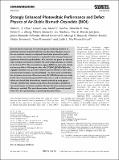Strongly Enhanced Photovoltaic Performance and Defect Physics of Air-Stable Bismuth Oxyiodide (BiOI)
Author(s)
Lee, Lana C.; Huq, Tahmida N.; Zhang, Kelvin H. L.; Kursumović, Ahmed; Stevanović, Vladan; MacManus-Driscoll, Judith L.; Hoye, Robert L. Z.; Kurchin, Rachel Chava; Sponseller, Melany Christine; Nienhaus, Lea; Brandt, Riley E; Jean, Joel; Polizzotti, James Alexander; Bawendi, Moungi G; Bulovic, Vladimir; Buonassisi, Anthony; ... Show more Show less
DownloadHoye_et_al-2017-Advanced_Materials.pdf (2.729Mb)
PUBLISHER_CC
Publisher with Creative Commons License
Creative Commons Attribution
Terms of use
Metadata
Show full item recordAbstract
Bismuth-based compounds have recently gained increasing attention as potentially nontoxic and defect-tolerant solar absorbers. However, many of the new materials recently investigated show limited photovoltaic performance. Herein, one such compound is explored in detail through theory and experiment: bismuth oxyiodide (BiOI). BiOI thin films are grown by chemical vapor transport and found to maintain the same tetragonal phase in ambient air for at least 197 d. The computations suggest BiOI to be tolerant to antisite and vacancy defects. All-inorganic solar cells (ITO|NiO x |BiOI|ZnO|Al) with negligible hysteresis and up to 80% external quantum efficiency under select monochromatic excitation are demonstrated. The short-circuit current densities and power conversion efficiencies under AM 1.5G illumination are nearly double those of previously reported BiOI solar cells, as well as other bismuth halide and chalcohalide photovoltaics recently explored by many groups. Through a detailed loss analysis using optical characterization, photoemission spectroscopy, and device modeling, direction for future improvements in efficiency is provided. This work demonstrates that BiOI, previously considered to be a poor photocatalyst, is promising for photovoltaics.
Date issued
2017-09Department
Massachusetts Institute of Technology. Department of Electrical Engineering and Computer Science; Massachusetts Institute of Technology. Department of Materials Science and Engineering; Massachusetts Institute of Technology. Department of Mechanical EngineeringJournal
Advanced Materials
Publisher
Wiley Blackwell
Citation
Hoye, Robert L. Z. et al. “Strongly Enhanced Photovoltaic Performance and Defect Physics of Air-Stable Bismuth Oxyiodide (BiOI).” Advanced Materials 29, 36 (July 2017): 1702176 © 2017 The Authors
Version: Final published version
ISSN
0935-9648
1521-4095